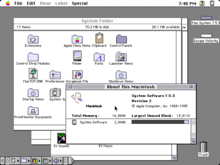- Control Strip
-
The Control Strip is a user interface component of the "classic" System 7 Mac OS which and remained until the Macintosh OS X system replaced the class Macintosh OS in December 2001.
Contents
History
The Control Strip was initially released in 1994 with the PowerBook 500 series of notebook computers and the PowerBook Duo 280 subnotebook computers, at that point shipping with System 7.1. Later on it was made available to desktop and portable Macintosh computers, beginning with System 7.5.3.
With the move to Mac OS X, Apple initially attempted to integrate the Control Strip’s features into the Dock. After this was found to be too clumsy, most of its features were again duplicated in the menu extras of 10.1.
Features
Somewhat like the system trays of other operating systems, the Control Strip allowed easy access to status information about and control of simple tasks such as screen resolution, AppleTalk activity, battery status etc. Each task appears as a button-like popup menu called a module, these modules are managed in the Finder as individual module files, which have their own folder in the System Folder ("Control Strip Modules") and are executed alongside the Control Strip as it starts up or can be dragged directly onto the strip while it is running.
The Control Strip always anchors itself to the closest horizontal screen edge (left or right,) but can be freely moved up and down both sides of any display by the user. It defaults to the lower left corner of the primary display on fresh systems.
Users can choose whether to turn the Control Strip on and off and even set a hot key to hide and reveal it using its control panel. Two buttons at either end allow the Strip to be collapsed and expanded (with the one opposite the screen edge also allowing the strip to be resized when dragged), while two more buttons just inside those allow one to scroll through a very full Strip. Holding down the option key while clicking turns the cursor into a distinctive hand shape that allows one to drag the Strip around the screen, rearrange modules within the Strip and drag modules out.
Extendibility
Control Strip modules were also available from many third-parties. For example, Conflict Catcher included a Control Strip module to switch extension sets, while DAVE used one to toggle SMB/NetBIOS networking. Some novelty modules even consisted of calculators, calendars and games. Like the System Trays of other OSs, this was often abused to insert a flotsam module that merely launched and quit a given application.
External Links
Control Strip Outlet at the Internet ArchiveFinal Update
Mac OS Applications Calculator · Chooser · Drive Setup · DVD Player · Finder · Graphing Calculator · Keychain Access · PictureViewer · PowerTalk · QuickTime Player · Network Browser · Scrapbook · Sherlock · Software Update · Stickies · Apple System Profiler · SimpleTextDeveloper Technology Alias · Apple menu · Balloon help · Bomb Error · Command (⌘) · Control Panel · Control Strip · Creator code · Hierarchical File System · HFS Plus · Keychain · Labels · Macintosh File System · Option (⌥) · OSType · PICT · QuickDraw · QuickTime · Resource fork · Special menu · Startup Screen · System Folder · System suitcase · Type code · WorldScriptRelated articles Categories:- Mac OS user interface
Wikimedia Foundation. 2010.

